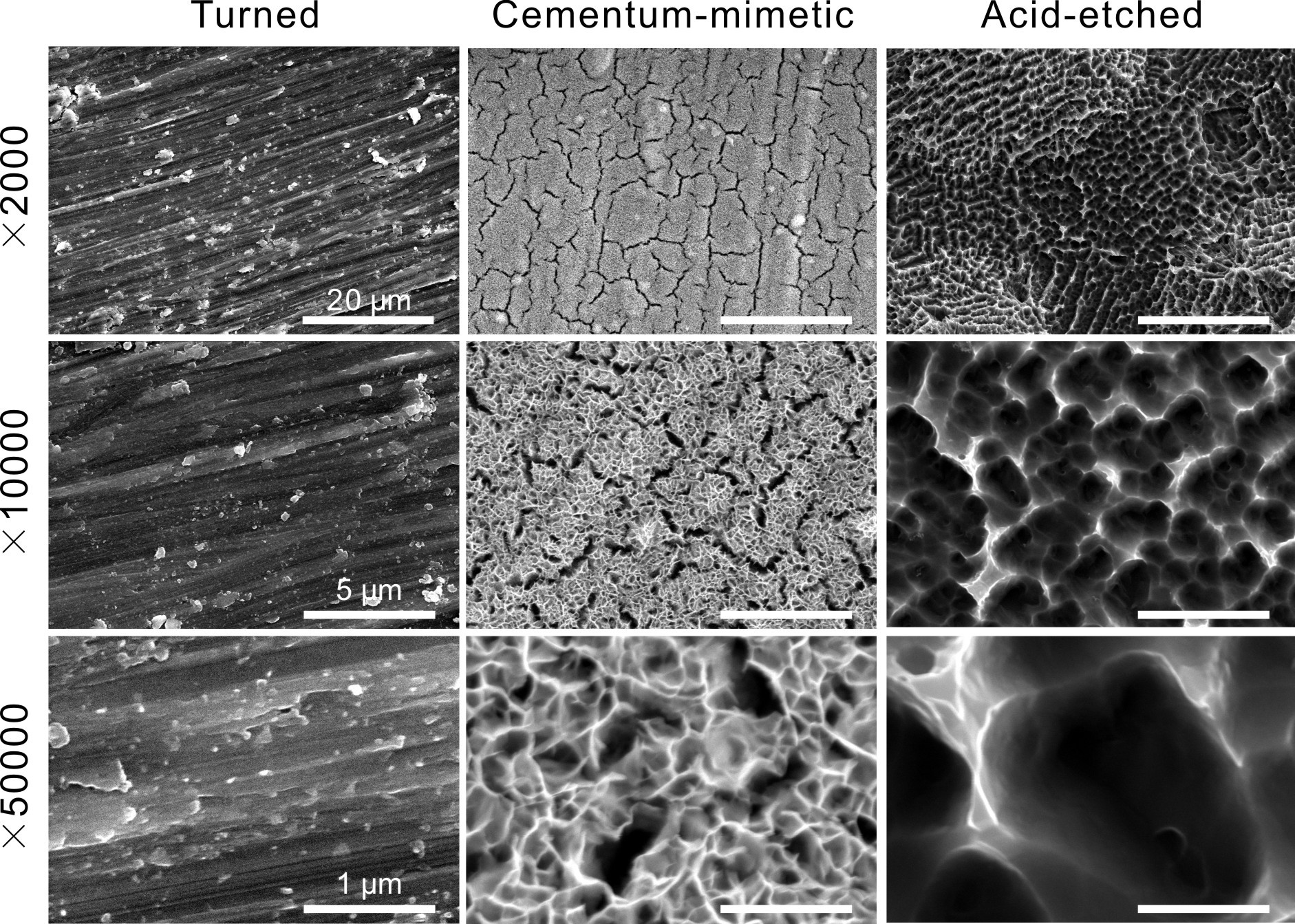IADR Abstract Archives
Periodontal-like Connective Tissue Attachment on Cementum-mimetic Titanium Surface
Objectives: Establishment of periodontal-like connective tissue attachment is one of the outstanding issues in implant dentistry. Biomimetics attracts attention as the powerful approach to evolve biomaterial and implant surface. We have created cementum-mimetic (CM) titanium surface with organized nanotopographic structures using alkali-heat treatment. This study aimed to evaluate gingival fibroblastic function and connective tissue attachment on the CM titanium surface in association with the topographic and nanomechanical properties.
Methods: Commercially pure titanium discs with turned, acid-etched or CM surfaces underwent topographical and nano-mechanical evaluations. Rat gingival fibroblasts cultured on the discs were evaluated in terms of cellular adhesion, proliferation, collagen synthesis and physicochemical binding strength of deposited collagen on the surfaces. Pure titanium mini-implants with turned or CM surface were placed on the hard palatal plate of rabbits and underwent histological evaluation at 8 weeks postoperatively.
Results: The CM surfaces exhibited monolithic structure with nano-crevasses or holes and numerous organized fine nanospikes in contrast with typical machined grooves or numerous micro-pits and sharp edges on turned or acid-etched surface, respectively. Nanoindentation hardness and elastic modulus of the CM surface were comparable with the values of human cementum in the literatures. The CM surface enhanced cellular adhesion and collagen synthesis without deterioration of proliferation, and toughened binding strength of deposited collagen sufficiently to resist against experimental overloading and inflammatory conditions by inclusion of collagen fibers into the surface, as compared with turned or acid-etched surfaces. Mini-implants with the CM surface incorporated gingival fibrous fibers into the surface, with fiber directions mimicking periodontal tissue in the transmucosal area. The feature was not seen on turned surface implants.
Conclusions: The nanotopographic titanium surface created by alkali-heat treatment mimicked human cementum both morphologically and physically. The surface enhanced gingival fibroblastic collagen production and acquired periodontal-like connective tissue attachment with substantial physicochemical strengthening.
Methods: Commercially pure titanium discs with turned, acid-etched or CM surfaces underwent topographical and nano-mechanical evaluations. Rat gingival fibroblasts cultured on the discs were evaluated in terms of cellular adhesion, proliferation, collagen synthesis and physicochemical binding strength of deposited collagen on the surfaces. Pure titanium mini-implants with turned or CM surface were placed on the hard palatal plate of rabbits and underwent histological evaluation at 8 weeks postoperatively.
Results: The CM surfaces exhibited monolithic structure with nano-crevasses or holes and numerous organized fine nanospikes in contrast with typical machined grooves or numerous micro-pits and sharp edges on turned or acid-etched surface, respectively. Nanoindentation hardness and elastic modulus of the CM surface were comparable with the values of human cementum in the literatures. The CM surface enhanced cellular adhesion and collagen synthesis without deterioration of proliferation, and toughened binding strength of deposited collagen sufficiently to resist against experimental overloading and inflammatory conditions by inclusion of collagen fibers into the surface, as compared with turned or acid-etched surfaces. Mini-implants with the CM surface incorporated gingival fibrous fibers into the surface, with fiber directions mimicking periodontal tissue in the transmucosal area. The feature was not seen on turned surface implants.
Conclusions: The nanotopographic titanium surface created by alkali-heat treatment mimicked human cementum both morphologically and physically. The surface enhanced gingival fibroblastic collagen production and acquired periodontal-like connective tissue attachment with substantial physicochemical strengthening.

